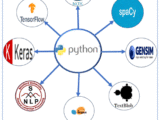
Machine Translation
September 12, 2023In a world characterized by global interactions and interconnectedness, language barriers can hinder effective communication and collaboration. However, with the rapid advancements in technology, particularly in the field of artificial intelligence (AI), these barriers are gradually being dismantled. Machine translation, a subset of AI, has emerged as a powerful tool that enables the automatic translation of text or speech from one language to another. This article delves into the realm of machine translation, exploring its understanding, types, key principles, impact, applications, challenges, and promising future.
Understanding Machine Translation

At its core, machine translation seeks to replicate the cognitive process of human translation using algorithms and computational methods. The goal is to produce translations that are accurate, coherent, and contextually relevant. This involves analyzing the grammatical structure, syntax, and semantics of the source language and generating an equivalent text in the target language. While early machine translation systems relied on rule-based approaches and dictionaries, the field has witnessed a paradigm shift with the rise of neural machine translation (NMT).
Types of Machine Translation

Machine translation can be categorized into three main types: rule-based, statistical, and neural machine translation. Rule-based systems rely on linguistic rules and dictionaries to translate text, but they often struggle with complex sentence structures and idiomatic expressions. Statistical machine translation, on the other hand, utilizes vast bilingual corpora to identify patterns and statistical relationships between words and phrases. Neural machine translation, the most recent breakthrough, employs deep learning models, such as recurrent neural networks (RNNs) and transformer architectures, to capture context and produce more natural-sounding translations.
Key Principles of Machine Translation
Machine translation systems operate based on several key principles. Firstly, the importance of context cannot be overstated. Words and phrases derive their meaning from the surrounding text, and successful translation requires understanding this context. Secondly, fluency and accuracy are often a trade-off; a translation might be fluent but lack accuracy in capturing the exact meaning of the source text, and vice versa. Thirdly, the availability and quality of training data greatly influence the performance of machine translation models.
Impact and Applications
Machine translation has made a significant impact on various aspects of our lives. In the realm of business, it has facilitated international trade, e-commerce, and communication between global partners. It has also played a crucial role in breaking down language barriers in travel and tourism, enabling seamless interactions between people from diverse linguistic backgrounds. Furthermore, machine translation is vital in the field of diplomacy, aiding in negotiations and international relations.
Challenges in Machine Translation
While machine translation has come a long way, it still faces several challenges. Some of them are listed below.
1. Ambiguity: Languages often contain words or phrases with multiple meanings, and the correct interpretation depends on the context. This is known as polysemy. Machine translation systems struggle to disambiguate words or phrases correctly, leading to errors in translation. Human translators rely on context and cultural knowledge to make sense of such ambiguities.
2. Idioms and Cultural Nuances: Languages are rich with idiomatic expressions, cultural references, and nuances that are difficult for machines to grasp. These elements often don’t have direct equivalents in other languages, making it challenging for machine translation systems to provide accurate translations that capture the intended meaning.
3. Syntax and Grammar: Differences in sentence structure, word order, and grammatical rules between languages pose significant challenges. Many languages have complex rules that are hard for machines to handle correctly. This is especially true for languages with free word order, such as Latin or Finnish.
4. Lack of Context: Machine translation systems often translate sentences in isolation without considering the broader context of the conversation or document. This can lead to translations that are contextually incorrect or inconsistent.
5. Domain-Specific Knowledge: Certain fields, like medicine or law, have specialized terminology and jargon that may not be well handled by general-purpose machine translation models. Translating accurately in such domains requires a deep understanding of the subject matter.
Path Forward
The path forward for machine translation is marked by continuous innovation and refinement. As technology advances, researchers are working on enhancing the quality of translations by integrating context and semantics more effectively. Cross-lingual transfer learning is a promising avenue, where knowledge gained from translating between certain languages can be leveraged to improve translations in related languages. In conclusion, machine translation stands as a testament to the remarkable progress achieved in AI and computational linguistics. From its humble beginnings to the complex neural networks driving modern systems, the evolution of machine translation has transformed the way we communicate across languages. While challenges persist, the potential of machine translation to foster global understanding, cooperation, and inclusivity is undeniable. As technology continues to push boundaries, the future of machine translation holds the promise of a more connected and united world.



